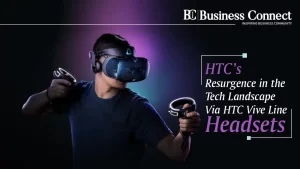HTC’s Resurgence in the Tech Landscape Via HTC Vive Line Headsets
Apple’s recently launched Vision Pro has taken the market with a new wave of excitement. In response to its recent foray, one of the leading consumer electronics firms, HTC expressed its enthusiasm and cited its potential to propel the technology into mainstream acceptance.
The market launch of Apple’s Vision Pro which is a virtual and augmented reality headset on February 2 marked a significant change in the world of tech giants and pitted it against competitors like HTC. To make a major comeback in the tech space, HTC strategizes its focus on the convergence of virtual and physical realities with its HTC Vive line of headsets.
Cher Wang’s insights

In view of the competitive spirit Apple has fuelled after the launch of Vision Pro, HTC’s CEO and co-founder, Cher Wang, welcomed the brand’s latest innovation and acknowledged the influence of Apple’s brand reputation at the global scale.
Also, she mentioned that the high price of Apple’s offering would be the pain point they wish to target. Wang emphasized that it serves as a catalyst for people to explore the capabilities of this evolving technology.
The fast integration of AR and VR mainstream adoption would chart a course to major product development in the future. And after researching the arena, Wang pointed to the lowering of price points and continuous technological advancements as catalysts for the worldwide adoption of this revolutionary technology.
The practical applications
Though the current reservations and limited adoption poses a halt in inclusion, the AR and VR headsets do have practical applications. In this reference, Wang mentioned an increasing use in professional settings, such as healthcare, where they simulate work experiences, aid surgical training, and assist law enforcement to combat the challenging backdrops.
Beyond terrestrial applications, Wang shared that HTC’s Vive Focus 3 headsets are even making their way to the International Space Station. There, they serve a dual purpose – helping astronauts stay physically active and providing visual stimuli, like images of Earth, to alleviate the psychological challenges of extended space missions.
“Astronauts talk about how they really miss greenery, the air, butterflies,” Wang explained. “It calms down their anxiety because it is such an enclosed space for many, many months.” According to Wang, it has the potential to revolutionize entertainment and gaming space, becoming an integral part of diverse sectors and even contributing to the well-being of those in extraordinary environments like space.
What could be anticipated for the future?
As per the report shared by IDC consultancy, the worldwide shipments of AR & VR headsets underwent an approximately 8.3 percent downfall last year, reaching 8.1 million units. This downturn has emerged due to dampened household consumption and slowed business spending due to rising inflation.
However, IDC anticipates a 46.4 percent rise in shipments for the current year. This optimistic outlook is fueled by factors such as the full year’s availability of Apple’s Vision Pro that would garner big attention. Moreover, the availability of Meta’s Quest 3, which hit the market in October 2023 would make the technology more affordable to be used by commoners.



